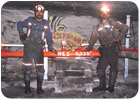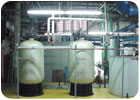
REI’s Randy Sparrow and Roger Benson.
Directional Drilling Record
REI Drilling Inc. (REI) announces that a new North American in-mine directional drilling record was established with its completion of a horizontal borehole to a length of 5,325 feet at CONSOL Energy’s Buchanan Mine near Mavisdale, Va. The meth-ane drainage borehole was one of five boreholes drilled by REI at the Buchanan Mine that exceeded 5,000 feet in length.The record borehole was completed by REI’s drilling supervisor and 24-year directional drilling veteran, Randy Sparrow; his crew comprised of directional driller Roger Benson and driller’s helper Andrew Rondinelli, with support from CONSOL Energy’s degasification and drilling crew, headed by Calvin Green.
Degasification improves the safety and productivity of the Buchanan Mine. The gas is gathered and sold by CNX Gas Corp.

Commercial Treatment Market Update
Depleting water resources and rising concerns about the quality of water is driving the North American markets for commercial water treatment equipment. The recent outbreak of water-borne diseases and prospects of bioterrorism are further accelerating this growth, especially with institutional end users such as factories and businesses providing safe water to employees.New analysis from Frost & Sullivan, North American Commercial Water Treatment Equipment Market reveals that the market earned revenues of $770 million in 2005, and estimates it to reach $1.1 billion in 2012.
This momentum is largely due to end users’ confidence about the efficiency and ease of maintenance of various water treatment technologies available in the market.
“While consumers’ familiarity with well-known water treatment equipment such as water softeners and filters is triggering the sales of the products, innovations such as chemical-free ultraviolet and ozone disinfection are creating new markets for manufacturers,” says Frost & Sullivan research analyst Yamini Ugender.
Improving standards of living and consumer consciousness about clean water are boosting the commercial water treatment equipment markets across North America. “While education campaigns by manufacturers and government regulations such as the Safe Drinking Water Act are increasing awareness about purified water, sustained product advertisement is translating into enormous sales for commercial water treatment equipment producers,” says Ugender.
Growth possibilities are further expanding since pollution of ground water in the region is forcing many market participants to explore newer technologies for providing clean water and treating contaminated water.
However, due to the availability of various technologies for treating high sediments, odor and taste, end users are finding it increasingly difficult to choose an appropriate solution for their specific needs.
“If end users install equipment not suited for a specific application, the equipment is not likely to deliver the solutions expected,” observes Ugender. “Educating consumers to make well-informed purchase decisions will increase their satisfaction with the product and help suppliers augment sales.”
To optimally leverage growth prospects across segments, market participants are carefully reviewing their core strategies. For instance, large manufacturers are intensely targeting broad segments, while regional companies are focusing on niche markets.
As the market continues to mature, economies of scale will become necessary in this price-sensitive market, calling for strategic consolidations. Manufacturers and distributors also need to closely monitor end users’ needs as well as market trends, and focus on innovation and cost restructuring to boost sales and profits.
While novel technologies provide newer sources of revenue, end users’ familiarity with the performance of established technologies such as water softeners and filters help sustain existing revenue streams. The availability of quality-certified commercial water treatment equipment further encourages uptake of these devices. To optimally penetrate this technology-driven market, manufacturers need to initiate brand-building exercises through value additions such as customer service packages.

Supporting the Troops
An American soldier stationed in Afghanistan, put in charge of a failing water well, knew he was stuck when the most popular solution proposed was throwing a grenade down the well. He contacted the “Ask the Well Guys” (www.WellDrilling.com), whose Mark Thein, in turn, contacted our Porky Cutter for his additional assistance. The specifics of the project cannot be divulged for security reasons (in the correspondence I received, the soldier is referred to as “Army Person”). What we can report security-wise is that the situation in Afghanistan has gotten to the point that the well has taken a back seat to the security of forces operating in the area. The soldier says, “We need 150 gallons to 200 gallons for the 55 of us each day, as long as we conserve. But, safe passage to and from … is the primary concern – so river water it is for now.” We wish the best for our troops, and are proud that the water well industry is ready to assist.Recent Legislative Issues of Note
Compiled by our dynamic, not-so-secret weapon, Caroline Mims:Water efficiency certification– Looking to expand the water efficiency market, the U.S. Environmental Protection Agency (EPA) has issued its first set of specifications to certify professionals in this field. Under the agency’s WaterSense program, the specifications identify technical standards for certifying landscape irritation professionals. Certification programs that meet the EPA’s standards are eligible for the WaterSense label. The programs will test for the ability to design, install, maintain and audit water-efficient landscape irrigation systems, including tailoring systems to the surrounding landscape and local climate conditions; selecting equipment, laying out irrigation systems and setting up proper scheduling; auditing systems that deliver water unequally or inefficiently; and recognizing how to improve performance.
Geothermal power boost – Sen. Harry Reid has called for more incentives to expand geothermal power productions, and has accused the White House of being slow to support renewable energy. Reid says U.S. energy companies need more incentives to produce geothermal power. A production tax credit to build new geothermal plants expires at the end of 2007, which means some plants on the drawing board could be scrapped if they lose a tax credit of 1.8 cent per kilowatt-hour. Reid states the geothermal plants cost money to build, and the tax credits for them have not been as favorable as for wind and solar.

Welcome John Schmitt
It is indeed our pleasure to welcome John Schmitt to our ranks as a contributing columnist. His bio and drilling industry resume would require its own double issue ofNational Driller; suffice it to say that everyone who knows him can attest that we’ll all be a lot better off with John sharing his knowledge and insights. Check out his first column in this issue.ND


Report Abusive Comment